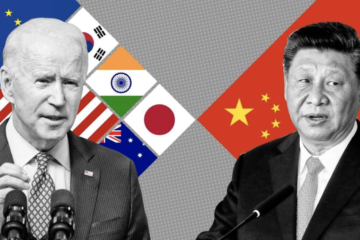Over 9-10 December, 2021, U.S. President Joe Biden held a ‘Summit for Democracy’, with the designated goals of establishing “an affirmative agenda for democratic renewal” and “tackl[ing] the greatest threats” facing democracies today. Yet, America’s actions at the summit suggested that the US truly intended to make the Summit for Democracy a forum to push the international community into two blocs – a democratic bloc led by the US, and an ‘autocratic’ bloc, which includes the likes of the People’s Republic of China – a divide reminiscent of the Cold War.
Over 111 states attended the summit at the invitation of the US, with the notable absence of China and Russia, as a result of being deemed ‘not democratic’. Alongside this, representatives of the island of Taiwan did attend the summit, despite opposition from Beijing. By not inviting China and Russia, it appears the US attempted to, in a sense, isolate them from the international community under the guise of defending against authoritarianism and to establish an informal bloc to counter their rise.
Despite Biden’s efforts, several states seemed unwilling to be forced into a second Cold War. Several participants appeared sceptical of the notion of forging a bloc in opposition to states like China. France, a NATO ally of the US, stated that, regarding China, they would oppose any kind of “bloc-against-bloc logic”. South Korea, a country which hosts approximately 30,000 US troops, shared a similar sentiment. Presidential candidate of the ruling DPK party, Lee Jae-myung, stated “Any thinking that we have to choose between the two (US and China) is a very disgraceful approach.”
This is not the first time the US has made an attempt to re-establish Cold War-esque geopolitical dynamics in international relations. During the G7 summit in June 2021, Biden declared that the West was “in a contest with autocrats”. Observers reasoned that the US objective for the G7 summit was to strengthen the US alliance with its European allies, and to try to contain China’s growing global influence. Yet the US faced similar challenges at G7. French President Emmanuel Macron stated at the end of the summit that there would be no “automatic alignment with Washington”, and questioned whether NATO should be at all focused on China, reasoning that “China is not in the North Atlantic”.
There are a great many reasons why much of the international community seeks to avoid a Second Cold War, a core reason being that unlike the Soviet Union, China has a much greater global economic presence. China is the largest trading partner for over 120 countries, it makes up over 18% of global GDP, and produces about one-third of all manufactured goods. Thus, a revival of a Cold War geopolitical dynamic would have significant global economic repercussions if tensions were to escalate, including for the US, which receives the largest amount of exports from China.
A further reason why many states are likely to be resistant to pursuing a bloc-against-bloc logic is that they already have other significant global issues to contend with. The pandemic continues to create major challenges for all states going into 2022, and climate change presents an ever-present challenge for countries worldwide. States risk wasting valuable time and resources to address these issues if they are forced to pick between either China or the US, as cooperation will become increasingly difficult. During the aforementioned G7 summit, the Italian Prime Minister, Mario Draghi, emphasised the need for the West to work with China in such areas – especially climate change – for China is increasingly a leader in areas of renewable energy such as solar and wind. The reemergence of Cold War-esque blocs could undermine this endeavour.
Much like the G7 summit that came before it, the Summit for Democracy saw the US once again try to encourage nations into picking a side through claims of democracy being at stake. By inviting the vast majority of the international community, and sidelining China, it seems clear that the US attempted to single out China and subsequently form, at least unofficially, an international ‘united front’ to confront and contain China’s rise. Yet the reason why such a tactic has not seen significant success is because the US has still failed to recognise that China is not another Soviet Union which can simply be ‘contained’. China is an integral part of the international community as the US is, and with the world facing much more drastic crises like that of the pandemic and climate change, very few states have the appetite for a new Cold War.


